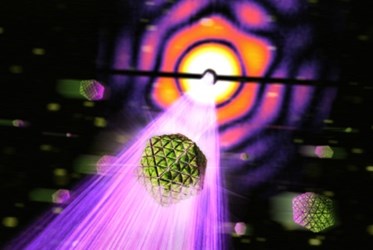X-Ray Laser Imaging Advances To Nanometer Scale
By Chuck Seegert, Ph.D.

Using an X-ray laser to create diffraction patterns, scientists were recently able to visualize individual carboxysomes without crystallizing them. At about 115 nanometers, carboxysomes are the smallest biological specimen studied by an X-ray laser to date.
Cyanobacteria, also known as blue-green algae, are very important pieces of the world’s ecosystem. This organism and others involved in photosynthesis perform a function called carbon fixation, whereby carbon dioxide is taken from the atmosphere and turned into a solid molecule, usually a carbohydrate. The organelles, or sub-cellular structures, that perform this activity in cyanobacteria are called carboxysomes.
Carboxysomes are very small and measure about 115 nanometers in diameter, according to a recent press release from Uppsala University in Sweden. The particle is much smaller than anything that can be measured with a microscope. Additionally, it is a challenging structure to study because, like many things in biology, it varies in size and shape between different cells. This variability makes it very difficult, if not impossible, to crystallize.
The Uppsala team used a new high-throughput system that took carboxysomes and streamed them in an aerosol across the path of a laser, according to a recent study published by the team in Nature Photonics. Approximately 70,000 samples were tested in about 12 minutes by using flash-diffractive imaging to perform structure determination on the carboxysomes.
"With the carboxysomes we have reconstructed the smallest single biological particles ever imaged with an X-ray laser, and we were also able to improve resolution,” said Max Hantke, a doctoral student in molecular biophysics at Uppsala University in Sweden, in the press release. “The reconstruction shows details as small as about 18 nanometres. For the first time we access a very interesting size regime with an X-ray laser. Large pathogenic viruses like HIV, influenza-, and herpes virus are in the same size domain as the carboxysome.”
As the samples pass through the laser, they are destroyed by the intense X-ray energy, but an accurate diffraction pattern can be obtained prior to this, according to the press release. This method, sometimes referred to as “diffraction-before-destruction,” was first proposed by the team at Uppsala in 2000.
“These results show the way to high-throughput imaging of biological samples at high resolution,” said Filipe Maia, Hantke’s supervisor, in the press release. “High data rates and very short exposures allow studies on the dynamics of particles and permit the analysis of structural variations, which are crucially important for life.”
Studying other aspects of photosynthetic processes has also been performed with an X-ray laser. Recently, the photosystem II protein was studied in a crystalline form, according to a recent article published on Photonics Online.
Image Credit: Carboxysome Artwork, SLAC National Accelerator Laboratory
